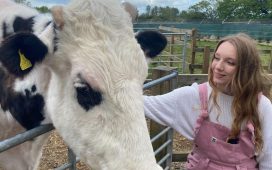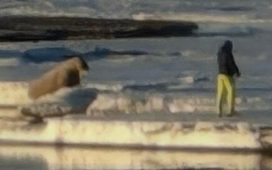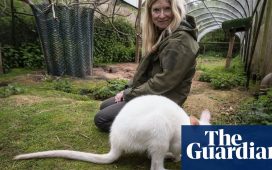When I finished up in a busy job in the middle of 2021, not many people asked why. Instead, they asked what I would do next, suggested jobs they thought I could apply for, or jobs I might have already secured – vast and exciting-sounding things, for sure. Well, no, I said. My plan was to sit in the garden and pat the dog for a while.
I don’t think I’ve ever delivered news that more people responded to with smiles, sighs and envy.
The dog is a reddish-brown and white dog with many influences. Cattle-dog stocking-spots on his legs. A jack russell’s head and its paws-in-the-air sleeping preference. Some labrador – we know that from his mother; the jack russell came from her too. The eyeliner of an Egyptian pharaoh. At 35kg, as one friend has observed, he’s the size of a small horse, and weighs well over half what I do. He believes himself to be very small, and he works in a constant space of now, remonstrating with passing possums and noisy miners, always ready for a walk. He looks like the kind of dog a child might draw if given a crayon and minimal instruction. And his fur is soft and silky – which is how it comes, rather than anything to do with sardines or egg yolks or any of the other foods people have asked about after patting him.
He’s been with us for all but the first three months of his almost-six years, having been rescued, just four weeks old and along with his mum and the rest of his litter, in a condition described as riddled with tapeworm and distinctly underweight. On his first night he woke up crying at midnight – we wondered if he’d ever had to sleep alone before. We wrapped him up in one of my jumpers and he went straight back to sleep. His midnight crying didn’t come again.
To sit with him, to feel the softness of his fur; this is one of the most happy things I know to do. It’s always felt like an exchange of present and content calm during these existentially stressful years – climate change, Covid, war, burnout, politics and its ongoing scandals, outrageous irresponsibilities, bad manners and inequities. Change of life. Life. Children growing bigger, becoming themselves.
The dog had scored a lot of patting thanks to all these things, his presence an invitation to a warm and furry pause from worrying about any of it. But I was sure I’d seen a reference to a study – something, somewhere – that revealed that patting a dog transferred stress directly from the hand of the human patter into the fur of the canine pattee. And so I worried about such a transfer, while continuing to share my stress across our human-canine dyad (as I later discovered our relationship is called by people who research these interactions).
That softness was pretty addictive.
Now, I wonder more and more: if patting this dog helped make me happier, calmer, more present and more curious again; if it gave me moments to balance this now against the constant rush of all that’s coming next, how has it affected him? Would being patted by a happier and calmer human now offset the stress he’d had to soak up previously?
I find research that links dog ownership with lower risks of cardiovascular diseases and death. Research that links patting a dog with lower cortisol levels and increased oxytocin levels in humans, both of which work to keep blood pressure lower. Research that correlates dog ownership with better mental health and social connection – all the way through to benefits for people with PTSD. Work from Uppsala. Work from Belfast. Work from Boston. And – yes – a study exploring synchronous stress levels between dogs and their owners.
And in this work I find a description of the way human hair – and dog fur – provide what researchers call “a promising matrix to assess long-term cortisol concentration”. “As the hair grows, cortisol from the blood is gradually incorporated,” writes this research team from Linköping in Sweden, “in effect forming a retrospective calendar of cortisol concentrations.” It sounds like a more personal version of the climatic information that can be retrieved and read from ice cores. This makes it possible to study the idea of “long-term stress synchronisation”, the researchers write, examples of which have previously been found “in the synchrony of hair cortisol concentrations between mothers and their children”. So perhaps not just love me, love my dog, as the old saying goes, but, stress me, stress my dog – oh, and yes, my child as well.
This feels, in some ways, like a whole other kettle of sardines in terms of the ways my happiness and the happiness of my hound are intertwined. But it does lead me to the notion of emotional contagion, a form of social convergence that sees “the spontaneous spread of emotions and related behaviours”, like smiling back at a person who smiles at you in the street.
Beyond the small space of me and my dog in the garden, and in the realm of both hope and despair – or call it stress, or call it being human – this feels like a useful thing to explore at this moment in time. And any useful thing to explore feels like a source of potential, and joy.
Call it happiness.
…
I’m writing this with my toes resting against the warmth of the dog, asleep under my desk, snoring sometimes and dreaming now and then. In a minute he’ll wake up and nudge me on the knee to point out that I’ve been working away for a while now: maybe we should both head out into the world?
And so we’ll walk together towards the end of this day – perhaps a better undertaking for both of us than many other things. As is the privilege of loving and being loved. Which is perhaps what it’s all about.
-
Ashley Hay is the author of A Hundred Small Lessons, Gum, and is the former editor of Griffith Review






